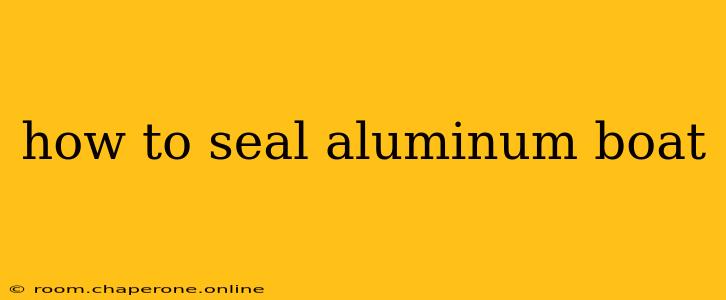Aluminum boats, prized for their lightweight durability, can succumb to leaks and corrosion over time. Understanding how to effectively seal an aluminum boat is crucial for extending its lifespan and ensuring safe, enjoyable use. This comprehensive guide covers various sealing techniques, addressing common leak sources and providing preventative maintenance advice.
Identifying the Source of the Leak
Before you begin sealing, pinpointing the leak's origin is paramount. A thorough inspection is essential.
Common Leak Locations:
- Rivets and Seams: These are frequent culprits, especially in older boats. Look for discoloration, corrosion, or visible gaps.
- Welds: Imperfect welds can create weak points prone to leaks. Check for cracks or porosity in the weld lines.
- Holes and Punctures: These are often obvious, resulting from impacts or damage.
- Transom: The transom (the back of the boat) can deteriorate, leading to leaks, especially if the boat has an outboard motor. Inspect carefully for cracks or softness in the wood or aluminum.
Leak Detection Techniques:
- Visual Inspection: Carefully examine the entire boat, both inside and out, looking for any signs of moisture or damage.
- Water Test: Fill the boat with water and observe for leaks. You can use food coloring to better visualize the water escaping.
- Pressure Test: Use an air compressor to pressurize the hull. Listen for escaping air, and use soapy water to pinpoint leaks. Caution: Never over-pressurize the hull.
Sealing Materials and Techniques
Once you've identified the leak, you can choose the appropriate sealing method.
1. For Minor Leaks and Surface Cracks:
- Marine-Grade Silicone Caulk: This is a versatile sealant suitable for many minor leaks. Apply it neatly, ensuring good adhesion to the surrounding surface. Allow ample drying time before using the boat.
- Epoxy: Epoxy is a stronger, more durable option for larger cracks or surface damage. It requires proper mixing and application. Follow the manufacturer's instructions carefully.
2. For Leaks Around Rivets and Seams:
- Aluminum Sealant: Specifically designed for aluminum, these sealants offer excellent adhesion and corrosion resistance. Apply thoroughly, ensuring complete coverage of the rivet or seam.
- Riveting: In cases of severely damaged rivets or seams, replacing them might be necessary. This is a more advanced repair and requires specialized tools and skills.
3. For Larger Holes and Punctures:
- Aluminum Patching: For sizable holes, a metal patch may be needed. Clean the area thoroughly, apply epoxy or sealant, and securely attach the patch using rivets or sealant.
4. Transom Repair:
Transom repair is often complex and may require professional assistance. Depending on the extent of the damage, it could involve replacing sections of the transom or undertaking a complete rebuild.
Preventative Maintenance
Regular maintenance is key to preventing leaks and extending the life of your aluminum boat.
- Clean Regularly: Remove dirt, debris, and saltwater regularly to prevent corrosion.
- Inspect Frequently: Regularly check for signs of damage, leaks, or corrosion.
- Waxing: Waxing your boat protects the aluminum from the elements and helps prevent corrosion.
- Proper Storage: Store your boat properly, ideally indoors or under a cover, to protect it from the weather.
When to Seek Professional Help
For extensive damage, complex repairs (like transom repair), or if you're unsure about any aspect of the repair process, it's best to consult a professional boat repair shop. Improper repairs can worsen the problem and compromise the safety of your boat.
By understanding the causes of leaks, selecting the right sealing materials, and performing regular maintenance, you can keep your aluminum boat in top condition for years to come. Remember safety is paramount; if you are unsure about any aspect of the repair, consult a professional.

